Institutional Funding

Reference: CLU-2O23-2-01
Beneficiary: Fundación de Investigación del Cáncer de la Universidad de Salamanca
Type of request: Granted aid, requested through Access Route 2, as per section four.b) of the Order of December 14, 2023, issued by the Department of Education - Ayudas concedidas, solicitadas por la vía 2 de acceso, del apartado cuarto.b) de la Orden de 14 de diciembre de 2023, de la Consejería de Educación
Funding: 1.000.000,00 €
Duration: 12/2024 – 12/2026
Title: Plan de Mejora del Centro de Investigación del Cáncer de Salamanca
Cualquier persona que tenga conocimiento de hechos que pudieran ser constitutivos de fraude o irregularidad (en los términos establecidos en la Comunicación 1/2017 del SNCA de 6 de abril) en relación con proyectos u operaciones financiados total o parcialmente con cargo a fondos procedentes de la Unión Europea en el marco de la presente convocatoria, podrá poner dichos hechos en conocimiento del Servicio Nacional de Coordinación Antifraude (SCNA) de la Intervención General de la Administración del Estado, por medios electrónicos a través del canal habilitado al efecto por dicho Servicio en la dirección web:

